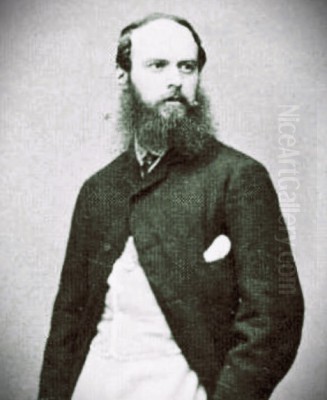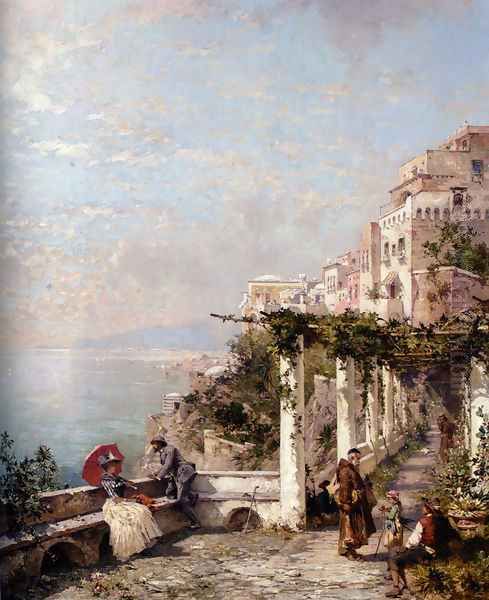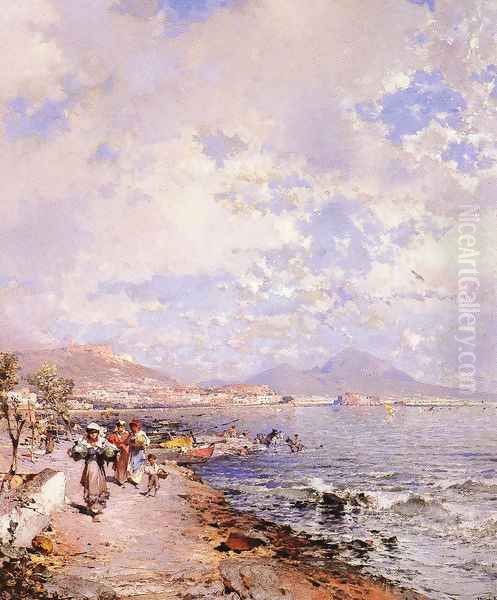Franz Richard Unterberger: Capturing the Romantic Light of Europe

Franz Richard Unterberger stands as a significant figure in nineteenth-century European art, an Austrian painter celebrated for his luminous and detailed landscape paintings, particularly those depicting the sun-drenched vistas of Italy. Born in Innsbruck, Austria, in 1837 (though some sources cite 1838) and passing away in Neuilly-sur-Seine, France, in 1902, Unterberger's life spanned a period of dramatic change in the art world. Yet, he remained largely devoted to a Romantic sensibility, infused with the precision learned from the German academic tradition, creating works that captivated audiences with their beauty, detail, and atmospheric charm. His paintings, especially of Venice and the Amalfi Coast, became highly sought after, cementing his reputation as a master of the picturesque European landscape.
Early Life and Artistic Formation
Unterberger hailed from Innsbruck, the capital of Tyrol, a region known for its dramatic Alpine scenery. His family background was steeped in the arts; they were involved in the art trade, providing an environment likely conducive to his early artistic inclinations. This familial connection perhaps offered him initial exposure to paintings and the art market, potentially shaping his understanding of popular taste and commercial viability from a young age. His formal artistic training began not in his native Austria, but in Germany, a common path for aspiring artists from the Austro-Hungarian Empire seeking rigorous academic instruction.
He initially enrolled at the Munich Academy of Fine Arts, a prominent institution known for its strong tradition in historical and landscape painting. Here, he studied under notable landscape painters such as Albert Zimmermann and Julius Lange. Zimmermann, known for his heroic and often dramatic Alpine scenes, and Lange, who also specialized in mountain landscapes and later became a drawing teacher to royalty, would have provided Unterberger with a solid foundation in landscape composition and technique, likely emphasizing the grandeur and sublime aspects of nature prevalent in German Romanticism.

Seeking further refinement and exposure to different artistic currents, Unterberger moved to Düsseldorf in 1859 or 1860. The Düsseldorf Academy of Arts was, at the time, one of the most influential art schools in Europe, particularly renowned for its school of landscape painting. This school emphasized detailed realism, often combined with narrative or allegorical elements, and a high degree of technical finish. His time in Düsseldorf proved formative, bringing him under the tutelage of arguably the most important landscape painters associated with the Academy: Andreas Achenbach and Oswald Achenbach.
Andreas Achenbach, a master of dramatic seascapes and northern landscapes, was known for his technical brilliance and realistic depiction of natural forces. His brother, Oswald Achenbach, became particularly famous for his colourful and atmospheric paintings of Italy. Oswald's influence is perhaps most evident in Unterberger's later career, guiding him towards the sunnier climes and picturesque motifs of the South, teaching him how to capture the specific light and atmosphere of the Mediterranean. The meticulous detail and vibrant palette seen in Unterberger's Italian scenes owe a significant debt to the Düsseldorf tradition, particularly as interpreted by Oswald Achenbach. Some accounts also suggest he received guidance or was influenced by the Academy's director, Wilhelm von Schadow, a key figure in German Romantic and Nazarene painting, though Schadow's direct impact on Unterberger's landscape focus might be less pronounced than that of the Achenbachs.
The Influence of Travel
Travel was fundamental to Unterberger's artistic practice and success. Like many artists of his era, he embarked on extensive journeys across Europe, seeking inspiration, honing his skills through direct observation, and gathering sketches and studies that would later be transformed into finished paintings in his studio. His travels were not merely touristic excursions; they were essential components of his creative process, allowing him to experience firsthand the diverse landscapes, light conditions, and cultural atmospheres that would become the hallmarks of his work.
His early travels took him north, exploring the dramatic scenery of Norway and Denmark around 1860. These northern landscapes, with their fjords, rugged coastlines, and cooler, often more diffused light, likely influenced his early work, perhaps fostering an appreciation for atmospheric effects and the power of nature. He also visited England, exposing him to the British landscape tradition, possibly encountering works by masters like J.M.W. Turner, whose atmospheric renderings of light and water, especially in his Venetian scenes, resonate with some of Unterberger's later interests, albeit approached with a different technique.

However, it was Italy that truly captured Unterberger's imagination and became the central focus of his oeuvre. His first trip south likely occurred in the early 1860s, and he would return repeatedly throughout his career. Italy offered a stark contrast to the northern landscapes: brilliant sunshine, vibrant colours, picturesque architecture, bustling street life, and ancient ruins steeped in history. This combination proved irresistible to Unterberger and perfectly suited the tastes of the burgeoning art market, which craved idyllic and romanticized views of the continent, fueled by the tradition of the Grand Tour.
Venice, Naples, the Amalfi Coast (including Positano, Amalfi, and Capri), and Sicily became his most favoured subjects. He excelled at capturing the unique interplay of light, water, and architecture in Venice – the shimmering reflections on the canals, the intricate facades of palaces like the Doge's Palace, the lively crowds on the Riva degli Schiavoni. His Neapolitan scenes often featured Mount Vesuvius looming in the background, fishing boats in the bay, and the vibrant life of the coastal towns. Further south, the dramatic cliffs of Amalfi and the ancient Greek temples of Sicily provided different, yet equally picturesque, motifs.
Brussels: A European Hub
After his formative years and extensive travels, Unterberger chose not to settle permanently in Austria or Germany, but rather established his primary residence and studio in Brussels, Belgium, from around 1864 onwards. Brussels, at the time, was a thriving cosmopolitan city with a vibrant art scene and excellent connections to other major European capitals, particularly Paris and London. This strategic location likely facilitated his international career, allowing him easy access to exhibition venues and a diverse clientele.
While based in Brussels, he became associated, at least geographically, with the Belgian art world, though his style remained firmly rooted in the German Romantic and Düsseldorf traditions. He maintained his focus on landscape painting, particularly the Italian scenes that had become his specialty. His Brussels studio served as the hub from which he managed his successful career, completing large-scale paintings based on the sketches and studies gathered during his travels. He regularly exhibited his works in Brussels, Paris, London, Vienna, and other major cities, gaining international recognition and patronage. His decision to operate from Brussels reflects a pragmatic understanding of the nineteenth-century art market and the importance of international exposure for achieving widespread success.
Artistic Style and Technique
Franz Richard Unterberger's art is best characterized as belonging to the later phase of Romanticism, blended with the technical precision and detailed realism associated with the Düsseldorf School. He was not an innovator in the vein of the Impressionists who were his contemporaries, but rather a master craftsman perfecting a popular and established style. His primary aim was to capture the beauty and atmosphere of specific, often famous, European locations, presenting them in an idealized yet believable manner.
Colour and light are central elements in his work. His palette is typically bright, luminous, and rich, especially in his Italian scenes. He skillfully rendered the warm glow of Mediterranean sunlight, the azure blues of the sea and sky, and the varied hues of stone, foliage, and local costume. He paid meticulous attention to the effects of light – how it illuminated architectural details, reflected off water surfaces, or cast deep shadows, creating a sense of depth and volume. This focus on light gives his paintings their characteristic vibrancy and atmospheric quality.
Detail and finish were also paramount. Influenced by the Düsseldorf Academy's emphasis on precision, Unterberger rendered architectural elements, foliage, boats, and figures with remarkable accuracy. Facades of Venetian palaces, the textures of ancient ruins, or the rigging of fishing boats are often depicted with near-photographic clarity. However, this detail rarely feels cold or purely documentary; it is always subservient to the overall romantic mood and picturesque composition. He often included small figures, known as staffage, in his landscapes – gondoliers, fishermen, elegantly dressed tourists, local peasants – which add life, scale, and narrative interest to the scenes, enhancing their anecdotal charm.
His compositions are carefully constructed, often employing established picturesque formulas. He frequently used framing devices like archways or foreground foliage to create depth, and diagonal lines (coastlines, canals) to lead the viewer's eye into the scene. While based on real locations, his views are often subtly idealized, perhaps combining elements or adjusting perspectives for maximum aesthetic appeal, a common practice in Romantic landscape painting. His work can be seen as a continuation of the European veduta (view painting) tradition, exemplified earlier by artists like Canaletto in Venice, but infused with the warmer palette, heightened atmosphere, and sentimental charm of nineteenth-century Romanticism. He differs significantly from the emerging Impressionists like Claude Monet or Pierre-Auguste Renoir, who, even when painting similar locations like Venice, prioritized capturing fleeting moments and the subjective experience of light and colour over detailed rendering.
Major Themes and Representative Works
Unterberger's artistic output revolved around several key themes, predominantly picturesque European landscapes. His reputation rests largely on his Italian views, which consistently found favour with collectors.
Venice was arguably his most iconic subject. He painted numerous views of the city, capturing its famous landmarks and atmospheric canals from various perspectives. Works often titled View of the Grand Canal, Venice, The Doge's Palace and the Riva degli Schiavoni, or simply Venetian Canal Scene are staples of his oeuvre. These paintings typically feature gondolas gliding on shimmering water, intricate Gothic and Renaissance architecture bathed in warm light, and lively scenes unfolding along the waterfronts. Schiavoni, mentioned in the initial prompt, likely refers to a depiction of the bustling Riva degli Schiavoni quay.
The Bay of Naples and the Amalfi Coast provided another rich source of inspiration. Paintings such as Amalfi Coast, View of Positano, or Fishing Boats off Capri showcase the dramatic meeting of mountains and sea, the charming cliffside villages, and the vibrant life associated with the southern Italian coast. He masterfully captured the intense blue of the Tyrrhenian Sea and the bright Mediterranean sunlight illuminating the colourful houses and lush vegetation.
Sicily also featured in his work, particularly its ancient Greek ruins. Views of the temples at Agrigento or Paestum (though Paestum is on the mainland near Naples, it shares the theme of classical ruins in a southern Italian landscape) allowed him to combine picturesque scenery with historical romanticism, evoking the grandeur of the classical past amidst the beauty of the present landscape.
While less numerous than his Italian scenes, his earlier Norwegian landscapes, often titled Norwegian Fjord or similar, demonstrate his ability to capture the different mood and light of the North. These works often emphasize the dramatic scale of the fjords, the ruggedness of the terrain, and the cooler, more silvery light, showcasing his versatility as a landscape painter.
A work like Road to Gompetsch, if accurately attributed and titled, would likely depict a scene from his native Tyrol, suggesting he occasionally returned to Alpine subjects, perhaps contrasting the familiar landscapes of his youth with the more exotic locales he became famous for painting. Across all these themes, his works are united by their technical polish, romantic atmosphere, and focus on capturing the unique character and beauty of each location.
Career Success and Recognition
Franz Richard Unterberger achieved considerable success and recognition during his lifetime. His paintings, with their appealing subject matter, technical brilliance, and romantic charm, resonated strongly with the tastes of the nineteenth-century bourgeoisie and aristocracy in Europe and America. He became one of the most commercially successful landscape painters of his generation specializing in these picturesque views.
He exhibited widely and regularly at major international venues, including the prestigious Paris Salon, the Royal Academy in London, and exhibitions in Vienna, Berlin, Munich, and Brussels. His participation in events like the Venice International Exhibition in 1883 and the London International Exhibition in 1885 further enhanced his international profile. These exhibitions not only brought critical attention but also connected him with dealers and wealthy patrons.
His success was formally acknowledged through various honours and awards. He was made a Knight of the French Legion of Honour, a significant recognition of his contribution to the arts by the French government. He also received the Austrian Order of Franz Joseph (sometimes referred to as the Francis Joseph Order), indicating high esteem in his home empire. Medals won at various exhibitions further testified to the quality and popularity of his work.
His paintings commanded high prices and were eagerly acquired by private collectors, particularly in Britain, the United States, and Germany, as well as in Austria and Belgium. While perhaps not as prominently featured in major public museums as some of his contemporaries who broke new artistic ground, his works are held in institutions such as the Ferdinandeum in his native Innsbruck and the Musée des Beaux-Arts in Troyes, France, among others. Many more reside in significant private collections worldwide and frequently appear on the art market, often fetching substantial sums, attesting to his enduring appeal. His commercial acumen, combined with his artistic talent, ensured a prosperous career.
Context and Contemporaries
To fully appreciate Franz Richard Unterberger's contribution, it's essential to place him within the broader context of nineteenth-century European art. He worked during a period of transition, where Romanticism, the dominant force of the early century, gradually gave way to Realism and later Impressionism and Post-Impressionism. Unterberger largely remained faithful to the Romantic landscape tradition, albeit one informed by the meticulousness of the Düsseldorf School.
His teachers and mentors, Albert Zimmermann, Julius Lange, and especially Andreas and Oswald Achenbach, represent key figures in German landscape painting who directly shaped his style. Oswald Achenbach, in particular, can be seen as a direct artistic precursor in terms of popularizing colourful Italian scenes within the Düsseldorf framework. Unterberger built upon this foundation, developing his own recognizable touch, particularly in his handling of light and atmosphere.
Within the Austrian context, he was a contemporary of prominent painters like the flamboyant historical painter Hans Makart, whose opulent style dominated Viennese art in the late nineteenth century, and Hans Canon, another successful academic painter. While Unterberger's focus on landscape differed from Makart's historical allegories or Canon's portraiture and historical scenes, they shared the stage in Vienna's thriving art world. He can also be contrasted with earlier Austrian masters like Ferdinand Georg Waldmüller, whose Biedermeier realism and meticulous attention to natural light offered a different, less overtly romanticized approach to landscape and genre scenes.
Internationally, Unterberger's work can be compared to other successful landscape and marine painters of the era. His detailed, luminous coastal scenes might invite comparison with the work of the Russian marine painter Ivan Aivazovsky, though Aivazovsky often focused more on the dramatic power of the sea itself. His picturesque views stand in contrast to the Barbizon School painters in France, like Jean-Baptiste-Camille Corot, who sought a more naturalistic and poetic rendering of landscape, often painted en plein air. And, as mentioned, his detailed Romanticism contrasts sharply with the revolutionary approach of the Impressionists, who were actively challenging academic conventions during the peak of Unterberger's career. Even artists focused on light and coastal scenes, like Eugène Boudin in France, adopted a looser, more sketch-like technique aimed at capturing atmospheric immediacy.
Unterberger carved out a distinct niche for himself, catering to a market that still appreciated highly finished, idealized, and evocative landscapes of famous and beautiful locations. He represented a successful continuation of the Romantic landscape tradition at a time when modernist movements were beginning to emerge, offering viewers captivating glimpses of Europe's scenic wonders.
Legacy and Conclusion
Franz Richard Unterberger's legacy lies in his mastery of the Romantic landscape, particularly his luminous and detailed depictions of Italy. He was not an avant-garde revolutionary, but rather an exceptionally skilled painter who perfected a popular style, capturing the allure of European travel destinations for an appreciative international audience. His paintings served as visual souvenirs, transporting viewers to sunlit Venetian canals, dramatic Amalfi cliffs, and historic Sicilian sites, all rendered with technical brilliance and atmospheric charm.
His work embodies a specific moment in nineteenth-century taste, where the desire for picturesque beauty, meticulous detail, and romantic sentiment converged. He successfully synthesized the rigorous training of the German academies with the inherent appeal of Mediterranean light and scenery. The enduring popularity of his paintings in private collections and on the art market today speaks to their lasting visual appeal and technical accomplishment.
While art history often emphasizes movements that broke with tradition, artists like Unterberger played a vital role in the artistic ecosystem of their time, fulfilling a demand for beauty and escapism. He remains a significant representative of the later Düsseldorf School's influence on landscape painting and a key figure among the many nineteenth-century artists who found inspiration in the landscapes of Italy. Franz Richard Unterberger's paintings continue to enchant viewers with their vibrant light, meticulous detail, and idealized visions of Europe's most celebrated vistas.